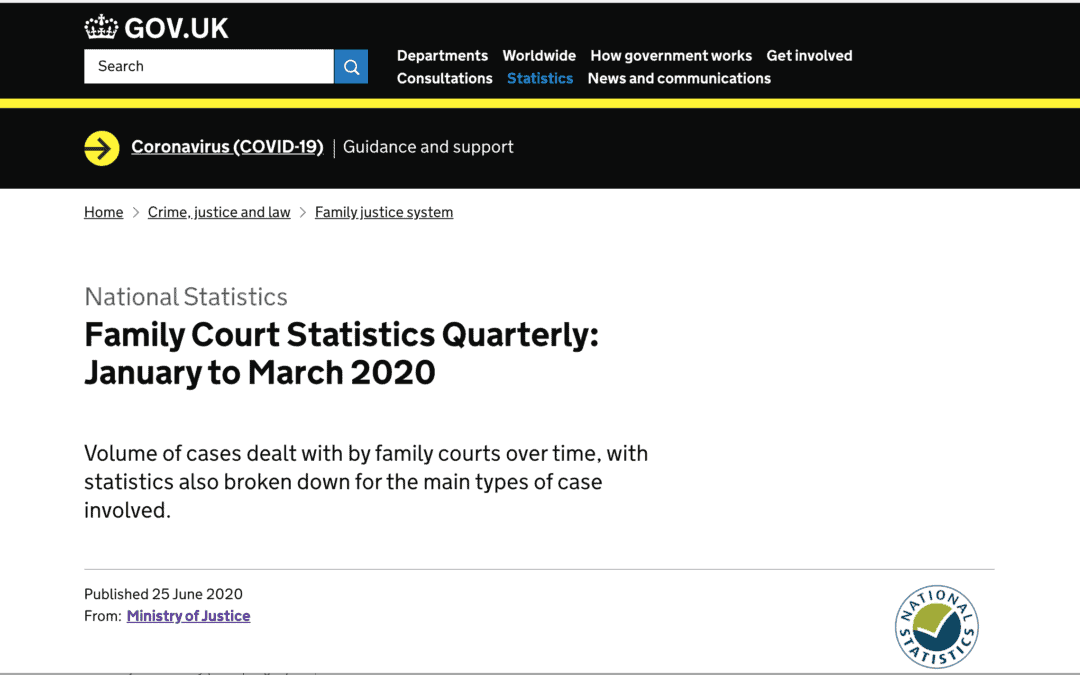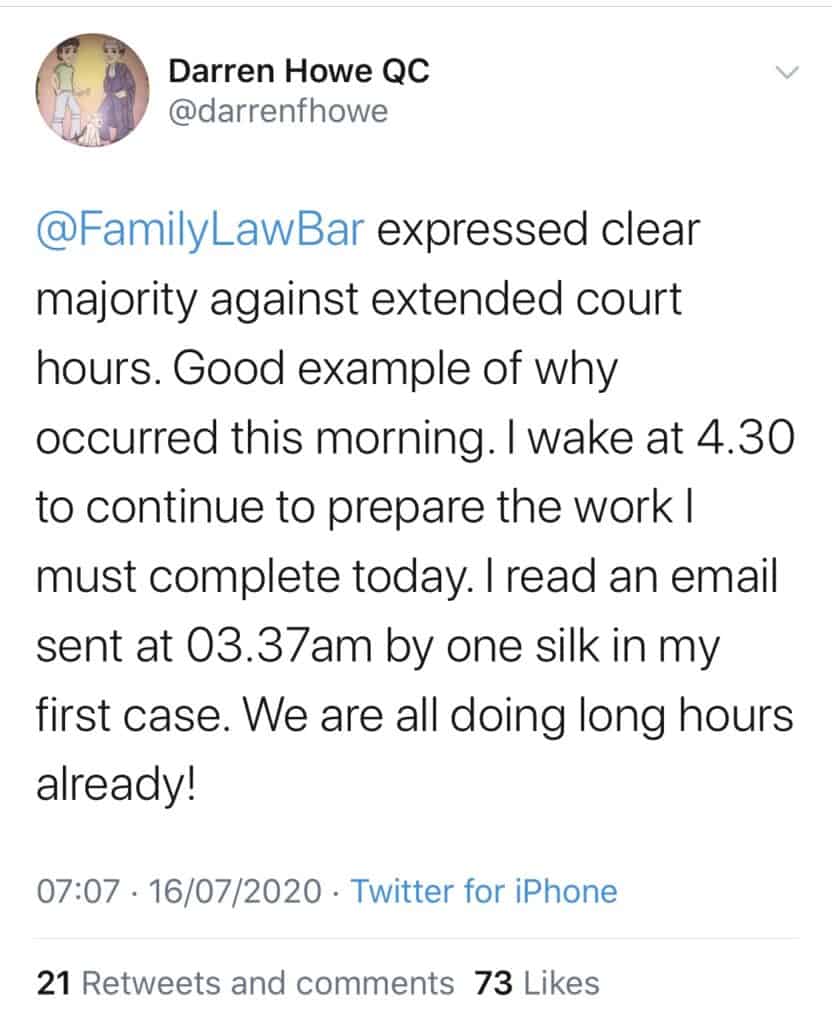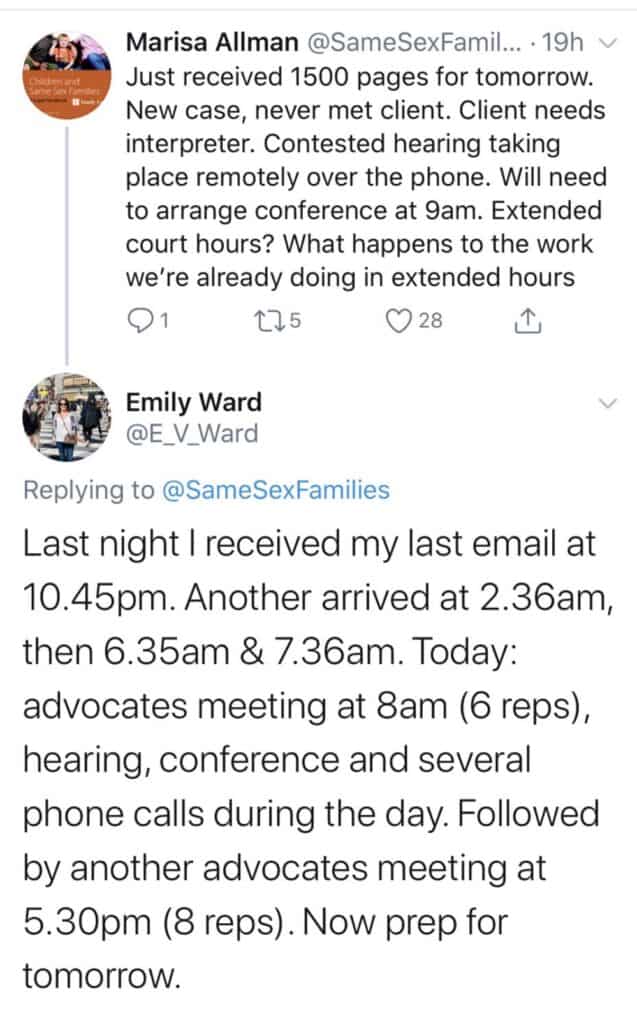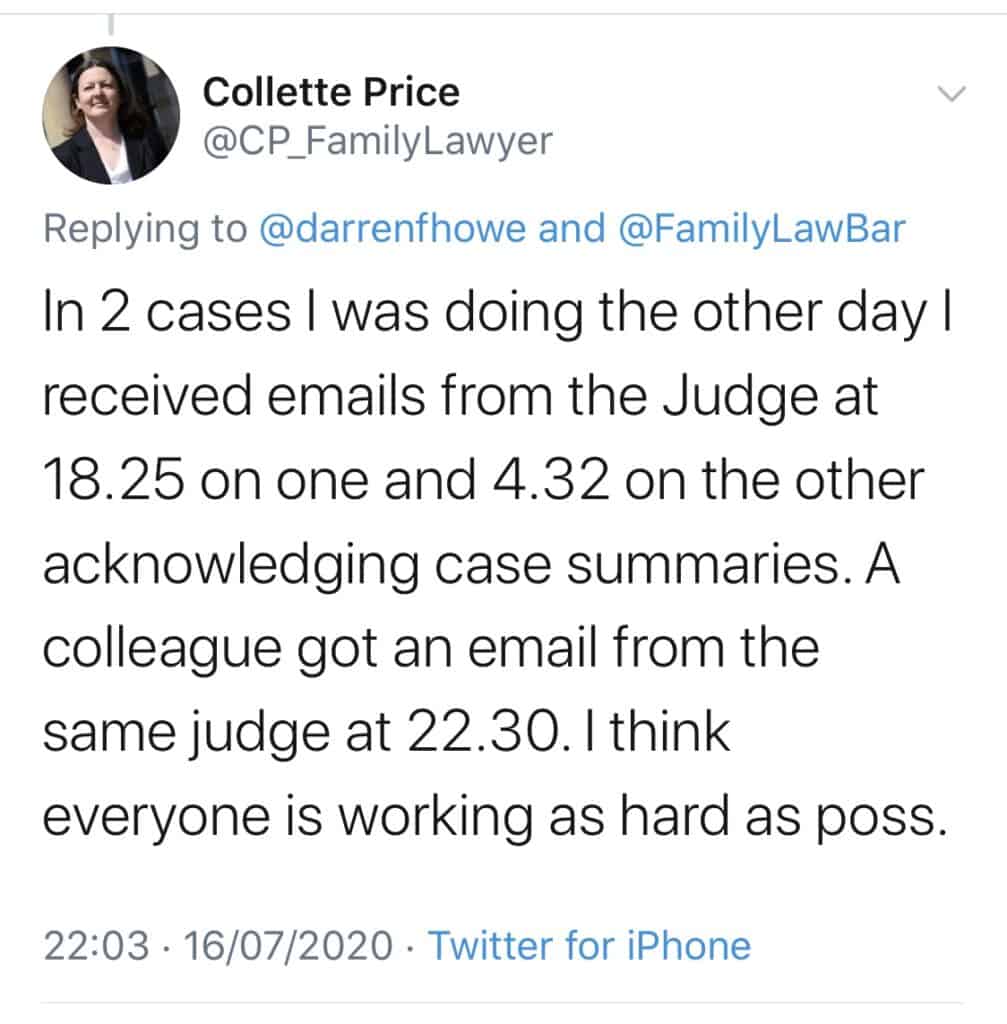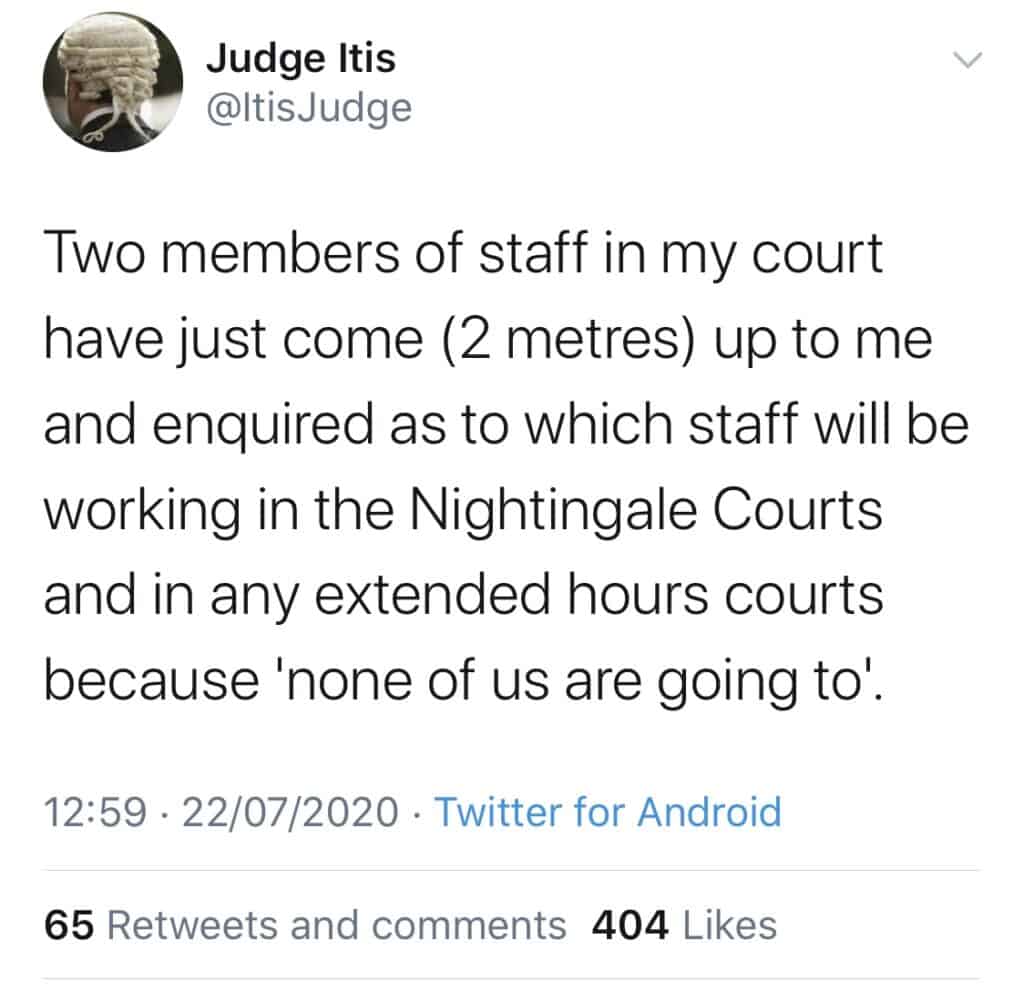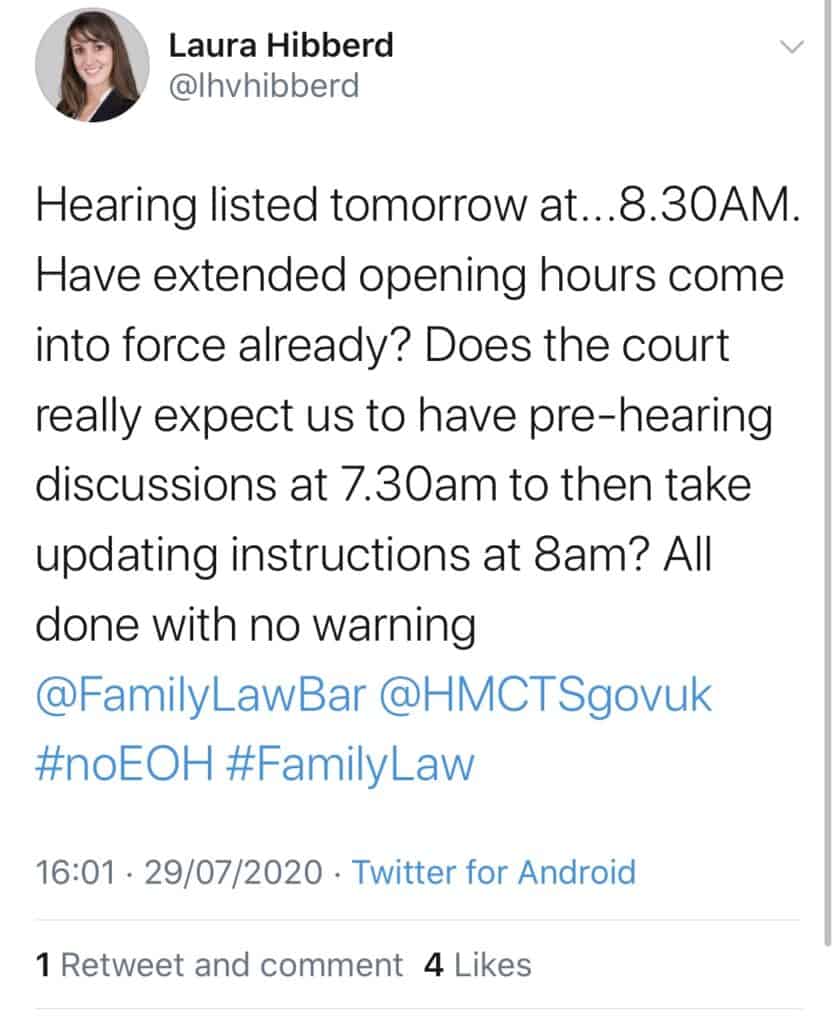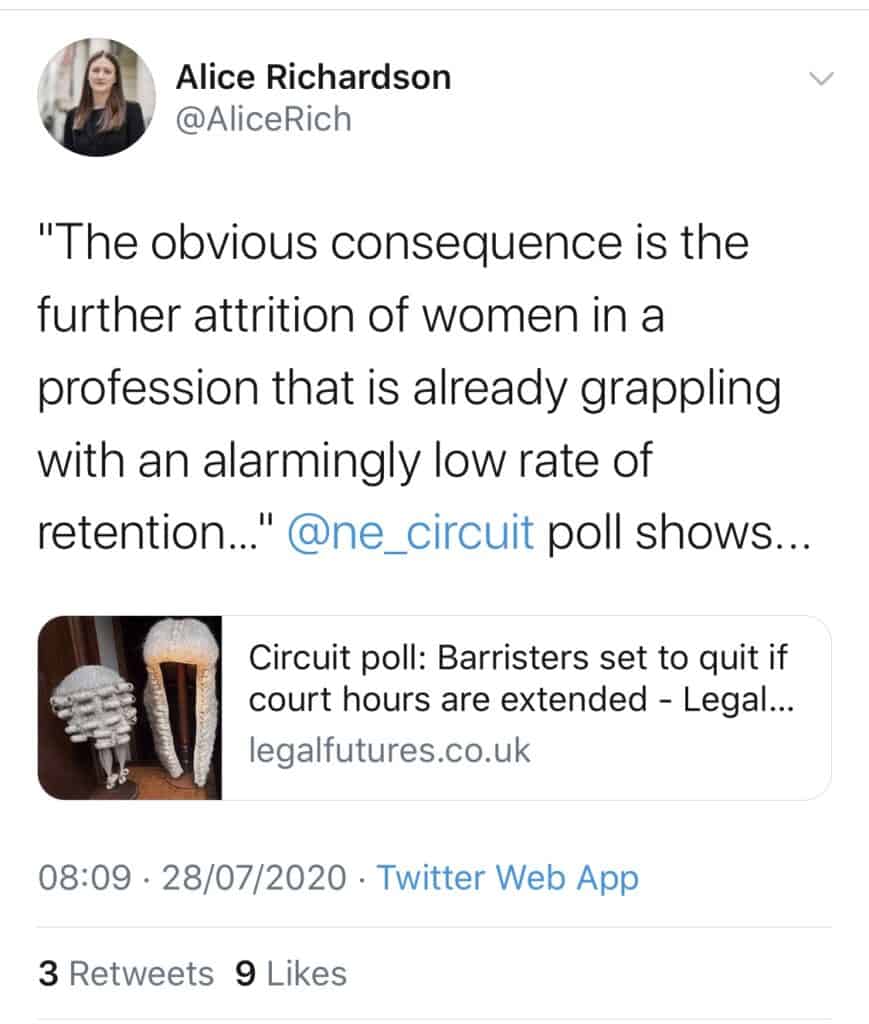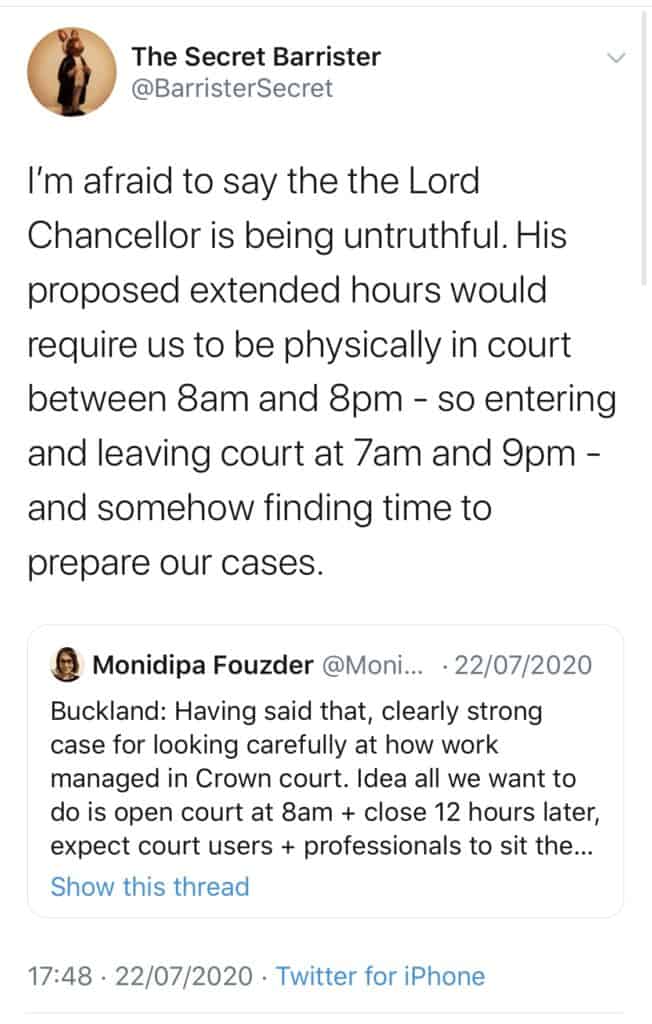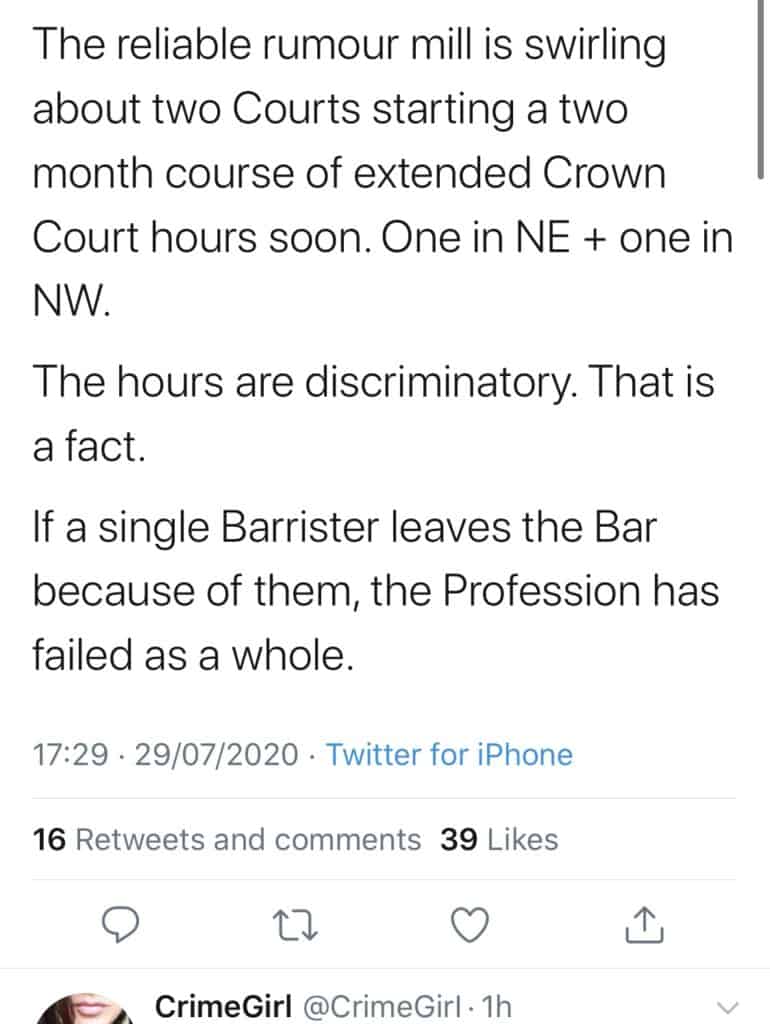This is a guest post by Jo Edwards, who tweets as @MissJoEdwards.
Last Sunday morning started pleasantly enough. Sun peeking through the shutters after being a no-show the day before; a cup of tea in bed; a visit to the gym looming and the prospect of friends visiting with their twins later in the day.
But as I glanced idly at Twitter – really a no-no before 9am on a Sunday – I noticed stirrings of discontent among the family law fraternity about an article in that day’s Telegraph entitled, “Divorcing couples face delays of 18 months”. The particular thread I saw noted that the article pointed to no fault divorce having already come into force – not yet – and that it would be based upon the “irrevocable breakdown of the marriage”. Grrrrr.
My interest piqued, and having navigated my way through the Telegraph paywall, I read the article in question and began inwardly to groan. Those who know me/have the misfortune to follow me on Twitter will know that I have spent most of lockdown tweeting photos, chronicling the fortunes of Manchester United in the rump of the season post-lockdown (Champion’s League football place secured on the Sunday in question – hoorah!) and critiquing any media article suggesting that there is going to be a huge spike in divorce enquiries post-lockdown based only on either the experience of a completely different jurisdiction thousands of miles away or one firm seeing a “40% increase in divorce enquiries” (5 enquiries rising to 7, anyone?). So cup of tea in hand, article in front of me, I opened up Twitter and began to type – no, to rant – about the offending bits of the article.
“Delays for divorcing couples have doubled because of coronavirus court backlogs that is forcing them to wait up to 18 months to legally separate”
Let’s unpick this sentence, for starters.
Submission number 1 in my mini-Twitter rant – “Worried that Covid being used as a ‘get out of jail’ free card – let’s be honest, the family court delays were already horrendous”.
Per the article, “internal court data” seen by the Telegraph showed that couples exiting lockdown are “waiting six months to finalise their decree nisi, compared with delays of three months before Covid-19″. So it’s clear that the measure of this statement was divorce data, not for example how long it takes to get a money or children application to final hearing.
Straight away I wondered – (a) 3 months from when? And (b) …erm, really?
Let’s go to the stats. Those who know me will be aware, I love a good stat. More particularly, I get especially excitable when the Family Court Quarterly Statistics are published. Those who share my penchant for all things statistical will know that the most recent FCQS were published on 25 June and covered the period 1 January to 31 March 2020. The eagle-eyed among you will also notice that that means that they cover only 7 working days of lockdown, so although for the entire period we knew about Covid and consumer behaviour was affected by the prospect of lockdown, the courts weren’t ostensibly affected by it for most of the period in question.
So what do the stats tell us? For Q1 2020, largely unblighted by Covid, the mean average time from petition to decree nisi was 28 weeks. So that’s, erm, already more than the 6 months that those exiting lockdown were said to be waiting, due to a “doubling in delays because of coronavirus court backlogs“. Around 6½ months, to be precise. But what if, for the avoidance of doubt, we delve back a year prior and look at Q1 2019, when the only term which filled news bulletins with as much regularity as Covid was Brexit (who misses those heady days?). Surely, if the Telegraph piece is to be believed, the decree nisi wait was only 12 weeks then? No, it was 33 weeks (or almost 8 months), 5 weeks longer than when we were on the brink of Covid chaos a year later.
In fact, the problem has been steadily worsening since 2015. In June 2019, Paul Maynard MP (then Parliamentary Under-Secretary of State for Justice), in answer to a question from Richard Burgon MP about the average waiting time was for a response from each HMCTS divorce centre in June 2019 and 2015, said that the average period from receipt to issue of the decree nisi is/was :
| Divorce centre | Petition to Decree Nisi June 2019 | Petition to Decree Nisi 2015 |
| Midlands | 27.6 weeks | 24 weeks |
| North East | 29.7 weeks | 21 weeks |
| North West | 29.1 weeks | 23.8 weeks |
| Wales | 28.5 weeks | 22 weeks |
| South East | 41 weeks | 24.7 weeks |
| South West | 26.8 weeks | 21.4 weeks |
Looking in more detail at the quarterly stats across the country for the last three years, they reveal delays which have continued to creep up :
| Quarter & Year | Mean average time petition to decree nisi |
| Q1 2020 | 28 weeks |
| Q4 2019 | 32 weeks |
| Q3 2019 | 30 weeks |
| Q2 2019 | 33 weeks |
| Q1 2019 | 33 weeks |
| Q4 2018 | 29 weeks |
| Q3 2018 | 31 weeks |
| Q3 2018 | 28 weeks |
| Q1 2018 | 27 weeks |
| Q4 2017 | 24 weeks |
| Q3 2017 | 24 weeks |
| Q2 2017 | 23 weeks |
| Q1 2017 | 24 weeks |
So, is the problem that the number of petitions is burgeoning? No. There were 29,540 divorce petitions filed in Q1 2020, down 3% on Q1 2019. Generally, over the last 5 years, the number of petitions issued has been fairly constant at between 27,000 and 30,000 per quarter, with the occasional outlier. In other words, although the number of cases has remained relatively constant, the amount of time taken to get to decree nisi has continued to rise.
What is more, the percentage of decree nisis relative to petitions issued in each quarter has plummeted over the years – from 95% in Q1 2015 to just 15.2% in Q1 2020. And if you will indulge me in just one more statistical table, just look at how the performance on that measure – percentage of decree nisis relative to petitions issued in each quarter – has deteriorated over the last two years (bearing in mind that between 2003 and 2017, barring one year which missed the mark by 0.1%, on average the number of decree nisis pronounced as a percentage of petitions issued per quarter has been over 90% every year) :
| Quarter & Year | Cases reaching decree nisi as a percentage of divorce cases started |
| Q1 2018 | 91.6% |
| Q2 2018 | 88.9% |
| Q3 2018 | 85.3% |
| Q4 2018 | 81.3% |
| Q1 2019 | 77.6% |
| Q2 2019 | 67.4% |
| Q3 2019 | 16.1% |
| Q4 2019 | 0.4% |
So I can’t see – and certainly don’t recall – that we were achieving decrees nisi within 3 months from issue any time in the recent past. This is very different from when I started practicing now some 22 years ago, when I would confidently tell clients that we could get decree nisi within 2-3 months of the petition and decree absolute within 4-5 months, subject of course to the finances being resolved. And I’m reminded that in 1999, my first full year of practice, there were almost 145,000 divorces in England and Wales. That fell to just shy of 91,000 divorces in 2018, the most recent stats we have. So a fall in the number of divorces of over 37% but a huge increase in how long the process takes.
So what’s to blame? Among the obvious answers :
- The eleven centralised divorce centres introduced in England and Wales in 2014 and 2015, with the vast majority of uncontested decree nisi applications being considered by Legal Advisers (rather than district judges), have been an unmitigated disaster. As cases have moved to the digital system, there have been closures of seven of the divorce centres, with only Bury St Edmunds, Liverpool, Southampton and Newport remaining. From January 2019 the digital service was extended to cover decree nisi applications online by those acting in person. It remains to be seen what is the impact on the speed of the divorce process by more of it moving online and it being fully opened up to solicitors.
- The courts modernisation programme, which started in 2016, has seen huge swathes of court closures and a move to cut the overall court staffing numbers from 16,500 to 6,500 by 2022. As the cuts have taken effect (and/or demoralised staff have left), before technology has been properly developed to cope, divorce has been but one casualty.
- There may be an argument that with the swingeing legal aid cuts which took effect in 2013, and the vast banks of litigants in person that have resulted, there has been an impact on the average pace of divorce as people don’t know how to progress things themselves and/or they have taken up (through absolutely no fault of their own) huge court resource in money or children applications as they don’t know where else to turn, leading to an impact on divorce timings.
Though it will be said – with some justification – that the online system will reverse the lengthening trend of the divorce process – and Q1 2020 is either the green shoots of that or else a blip – it has not been without difficulty and has yet to be rolled out wholesale to solicitors.
And what of evidence elsewhere in the system of how the family courts are faring? As I say, the Telegraph piece was based squarely on divorce statistics. Is it a better picture if one looks at say private law children applications in recent years? The short answer is – no. Over the past 7 years the number of applications has remained fairly constant (there was a 10 year spike of almost 47,000 applications in 2013, no doubt due to the then impending legal aid cuts, and since then an average of 38,000 to 42,000 applications per year). Although the impact of the CAP introduced in 2014 was to reduce the mean case duration from 30-31 weeks between 2011 and 2014 to 22.3 weeks by 2016, the past two years have seen deterioration in performance and in 2019 we were back up to a mean case duration of 28.3 weeks. Such cases have undoubtedly been a Covid casualty and we are already being warned of delays of 12+ weeks before getting a FHDRA.
The second part of the article intro reads, “forcing them to wait up to 18 months to legally separate”. In briefer fashion, let’s unpick that. There’s no legal definition of “separation”. People often approach me, not wanting to divorce (or even, sometimes, sort out their finances there and then), and ask me, what do I need to do to formalise my separation legally? The short answer, strictly speaking, is nothing. People can of course just separate and not have to wait 18 months (or any length of time) to do so. A different point, and perhaps one the article was hinting at, is – what if a divorcing couple need to sort out the finances, with the court’s help, so they can afford to separate? I come on to that point.
“They then face up to a year to agree a decree absolute if there are financial disagreements that have to go to trial”
Submission number 3 in my mini-Twitter rant – “You don’t “agree” Decree Absolute”.
Enough said on that point. It is granted, on the application (for now at least) of one spouse. In certain instances, it may be opposed. But you don’t ‘agree’ it.
But what of the suggestion that couples have to wait a year if money issues need to go to trial? As a broad proposition, that is probably right (and again, banging the same drum, nothing to do with Covid). On the money side, it is surprisingly difficult to come by hard stats. The Family Court Quarterly Statistics don’t set out the mean duration of a financial remedy case in the same way they do for other areas. It also seems that this is an area of the stats which is heavily caveated, with an entire table of financial remedy stats removed from the most recent bulletin due to the unreliability of the figures given.
What is clear though is that the proportion of financial remedy cases disposed, relative to those started in each quarter, has been gradually declining :
| Year | Financial remedy cases started | Financial remedy cases disposed | Financial remedy cases disposed as a proportion of financial remedy cases started |
| 2010 | 47,090 | 47,272 | 100.4% |
| 2011 | 44,505 | 44,590 | 100.1% |
| 2012 | 42,079 | 41,800 | 99.3% |
| 2013 | 40,426 | 39,865 | 98.6% |
| 2014 | 39,126 | 38,984 | 99.6% |
| 2015 | 42,215 | 39,105 | 92.6% |
| 2016 | 43,647 | 40,274 | 92.3% |
| 2017 | 42,018 | 38,706 | 92.1% |
| 2018 | 37,238 | 34,212 | 91.9% |
| 2019 | 18,086 | 13,137 | 72.6% |
Of course, on matters both financial and children-related, some couples have the option of arbitration. Anecdotally, arbitration cases have not seen a surge in numbers in the last 4 months despite the impact on the courts of lockdown. In the last couple of years, money arbitration cases hit around 125-150 per year and children cases a dozen or so. In the context of the huge delay in listing FHDRAs post-Covid, I have mused on Twitter – if now isn’t arbitration’s time, when is? I have had lively debates about why it is more couples don’t engage in arbitration (my own experience is that sadly, all too often tactical delay and waiting for a court listing suits one party); and should judges have power to direct people to go to arbitration (in my view, yes).
“[One law firm] has seen enquiries rise from 75 in March to 116 in June and 112 to date in July…”
Submission number 2 in my mini-Twitter rant – “Increases in client enquiries doesn’t mean increase in divorce – many don’t”.
I have written for the Transparency Project before about my irritation every New Year when the tabloids trot out the “Divorce D Day” tripe, the so-called phenomenon of a spike in divorce petitions on the first working day of the year (See here).
By the same token, I have become irritated during lockdown at newspaper inches being taken up with speculation about (a) a small increase in (b) enquiries (c) to one firm, being evidence of there about to be an explosion in the number of divorces. I refer to an earlier Twitter thread of 10 June
…and a further Tweet on 15 April (I have been busy) :
In short, one firm seeing an increase of enquiries from 75 in March to 116 in June is not evidence of any wider trend. How many enquiries did the same firm have in those months last year? What of the thousands of other family lawyers across the country? How many of our enquiries successfully go off to counselling, hopefully with our encouragement? More than anything – and I don’t suggest for a second that the lawyers quoted in the Telegraph article were doing this – we shouldn’t encourage divorce and be giddily rubbing our hands in glee at the prospect of a sharp uptick in divorces, if indeed that comes to pass.
“Since 25 June, no fault ‘quickie’ divorces are now legal meaning a spouse will simply have to claim that their marriage has irrevocably broken down”
Submission number 4 in my mini-Twitter rant – “No fault divorces (a) not “quickie”, 80% will be slower, (b) not yet in force, autumn 2021 likely, (c) not about showing marriage “irrevocably” broken down”.
I’m not sure I need to expand upon my written submission here. At the second reading stage of the Bill in June the Lord Chancellor Robert Buckland debunked the “quickie divorce” myth by reference to the stats, pointing out that at the moment there is no minimum timeframe for the process and the new law would introduce that (as we have seen from the stats – sorry to go there again – it seems fanciful to imagine that one could achieve a divorce within 6 months at present but online divorce may change that). We know that no fault divorce won’t likely be a reality until autumn 2021 (or spring 2022, by the time the first divorces complete) and the Family Procedure Rules Committee will work on the detail the rules underpinning the new legislation, particularly around the issue of service.
And “irrevocably broken down…”? Grrrr grrrr.
“We are saying to clients that we are expecting a minimum of six months to get the paperwork through the court system”
Submission number 5 in my mini-Twitter rant – “What about opening up online divorce fully to sols? Online financial orders much quicker”
Hopefully a glimmer of hope, but my experience of the online portal for consent orders has been positive and turnaround times speedy. It is not yet open to litigants in person but HMCTS insist that that is because in 86% of cases, contested and uncontested, people are represented… On the online divorce side, progress has been slow and solicitors have for a while been able to assist clients only if they use the portal for litigants in person. There is now a separate portal for legal professionals (though there have been glitches) and, gradually, further stages in the divorce process are moving online. Of course this will all need further revamping when no fault divorce becomes a reality.
“The MoJ is planning Nightingale courts, evening and weekend sittings and greater use of video hearings to increase capacity to clear the backlogs but the legal profession is resistant to longer hours”
Submission number 6 in my mini-Twitter rant – “The legal profession is NOT resistant to longer hours. For most, there are simply no more hours in the day (& the small matters of families, wellbeing, work/life balance). Lockdown has blurred the boundaries further”.
It was perhaps unfair of me to expect that, on a word limit, a journalist could be expected to do justice to the long history of discussion around Flexible Operating Hours and reflect the strength of feeling which exists around it. However, it was unfortunate that the clear impression the reader was left with was that a combination of Nightingale Courts, extended hours and greater use of video hearings could be used to resolve the (many years of, not just Covid-related) delays in the Family Courts – but that the evil legal profession was the blocker to that.
The most recent iteration of the plans was revived in 2017, against the backdrop of the courts modernisation programme. His Honour Judge Ticehurst, the resident Judge at Taunton Crown Court, summarised the feelings of most :
“In my view this experiment is misconceived and takes no account whatsoever of the realities of trials or other work in the Crown Court. In a small court centre like Taunton, if the scheme is to work you will immediately need to find two or more Judges or Recorders to cover the split shifts. We will need double the number of potential jurors. Prisoners will need to be brought to court by about 7.30am for a realistic start in the morning. At the moment on occasions some prisons do not get prisoners to us until 12 noon! Prisoners on the afternoon shift may not get back to their prisons until gone 8pm by which time there will be no food or meals available for them. We are already struggling with a lack of staff. Is HMCTS going to be able to recruit and fund more staff and/or pay them overtime to cover the new hours?…There is a very good reason that the courts traditionally sit 10am until about 4.30pm and that these hours have not changed. It is because it works”.
An online petition against the scheme garnered thousands of signatures. Lord Justice Fulford, in August 2019, in a letter sent to all Judges, hit out at “ill-informed comments” and “widely broadcast misunderstandings” and as the Senior Judge in charge of modernising the court service, he insisted that the plans were not a thinly veiled attempt to persuade or force legal professionals to spend more time in court than they already do. That did nothing to placate a rightly angry legal community.
Most recently the Lord Chancellor attracted much criticism when he said that, “There is a lot of support for this from not just the judiciary but the professions as well“, leading many to ask him to point to where that support could be found.
In The Law Society’s response to the proposals, they rightly cited :
- The potential for discrimination, particularly against those with childcare or other caring responsibilities, and certain religious groups;
- The increased pressure on legal aid practitioners;
- No practical measures having been identified to show that there will be safeguards to prevent longer working hours;
- Without means of determining court users’ availability and preference of when their case is scheduled, the pilot is not user-centric;
- The extension of hours will increase the costs incurred by the firms involved, which would have a devastating impact on those doing legally aided work;
- A point oft-referred to is the fact that the court utilisation data used by the MoJ to assess court use by professionals is flawed. This is a point to which I/Resolution and others have referred repeatedly when giving evidence to the Justice Committee in 2018 and the Public Accounts Committee in 2019 about court closures/the court modernisation programme.
Most striking, however, is to read in Twitter some of the comments of those working on the frontline, for whom there simply aren’t any more hours in the day :
End of rant
So let’s not stand behind Covid and blame a global pandemic for the length of time people are waiting to progress their divorces, or indeed money and children applications. The problems were there way before Covid and, like so much of the landscape at the moment, it will be a huge pity if the family courts (suffering from years of cuts, closures and under-resourcing at a time when ever more litigants in person and private law applications are crossing its threshold) is set back yet further as a result of the difficulties of the last 4 months.
Let’s not assume that one law firm seeing an increase in enquiries means that divorce numbers are about to go off the scale (and let’s certainly not wish that).
And let’s stop the lawyer-bashing shall we – and the suggestion that we are the problem when we could be the solution? We all know how hard family lawyers work. We know that legal aid has been slashed to the bone and that many are already being asked to work long hours on impossibly tight margins (and to offer up much of their time for free). Opening Nightingale courts is one thing, but they need judges and staff to populate them, lawyers to run the cases and proper funding. The system needs (and has long needed) wholesale investment; the impact of Covid just brings that into yet sharper focus.
We have a small favour to ask!
The Transparency Project is a registered charity in England & Wales run largely by volunteers who also have full-time jobs. We’re working hard to secure extra funding so that we can keep making family justice clearer for all who use the court and work within it. We’d be really grateful if you were able to help us by making a small one-off (or regular!) donation through our Just Giving page. You can find our page, and further information here.
Thanks for reading!
